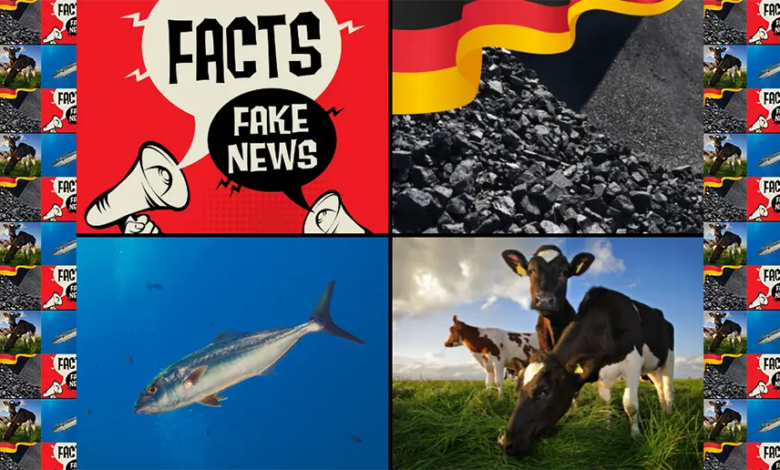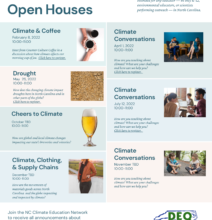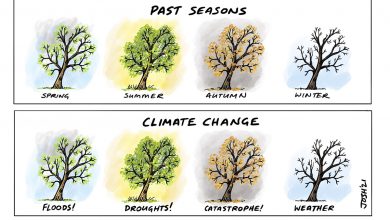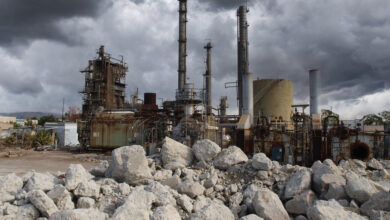How the Mainstream Media Uses Misdirection to Mislead About Climate Change – Watts Up With That?

YOU SHOULD SUBSCRIBE TO CLIMATE CHANGE WEEKLY.
IN THIS ISSUE:
- How the Mainstream Media Uses Misdirection to Mislead about Climate Change
- Video of the Week: The Planet is Getting Greener, and That’s a Good Thing
- Germany Turns Back to Coal to Keep the Lights On
- Animal DNA Suggests the Arctic Was Warmer in 7,000 B.C. than Today
- Research Suggests Cattle Raising May Reduce Emissions
- Podcast of the Week: Climate and Energy: the Case for Realism (Guest: David Legates, Ph.D.)
- Climate Comedy
- Recommended Sites
Watch ALL the Presentations by the ALL-STARS of Climate Realism at the Archive of Heartland’s 15 Climate Conferences
How the Mainstream Media Uses Misdirection to Mislead about Climate Change

Over the course of its operation, Climate Realism has posted more than 1,300 articles detailing the mainstream media’s malfeasance in asserting that all manner of natural and human disasters are being caused by climate change. We use real-world data to refute and rebut such claims every day and rebuke the media for acting as activists for a cause, rather than being journalists, checking facts about climate change and reporting them honestly.
Most of the articles Climate Realism has responded to make specific claims about the damaging impacts supposed human-caused climate change has or will cause based on specific studies. Sadly, more often than one might imagine, the connection between a specific weather disaster or environmental or societal problem and climate change is simply asserted, as if it was an established fact or common knowledge rather than being linked to a specific study or report.
As bad as it is having to refute articles referencing easily debunkable claims—claims that a middle schooler could fact check using the Internet, if he or she were so inclined, to show it to be false—there is a subset of articles Climate Realism responds to where climate change is basically a red herring. An article trumpets the fact that climate change is causing a particular problem in the headline, only to almost ignore it as a factor in the story. Climate change, to the extent it is mentioned at all as a problem, is only referred to in passing, while other factors—usually direct causal factors for the problem—are discussed in detail; but you’d never know about these real problems or issues from the headline.
This issue was brought to the forefront for me in responding to an Al Jazeera article this week for Climate Realism. The story, headlined “‘Nothing left’: How climate change uprooted an Indigenous village,” is misleading from the beginning, in two respects. First, the village in question has not been uprooted, rather it still exists where is has for generations, although the native population is considering moving on. Second, climate change not only is playing no role in the problems facing the natives in question, it is barely discussed as a factor in the story itself, although from the title, one would be led to believe that it is the whole story.
Concerning climate change, the story references the World Bank’s claim that climate change is one factor among many facing indigenous people around the world, but doesn’t even try to tie climate change factually to problems wreaking havoc in the lives of San Miguel Centro Marankiari indigenous peoples of the Ashaninka village in the mountains of central Peru.
Rainfall and temperatures in Peru are not outside the country’s historic norms, there is no long-term climate signal. It turns out problems in Ashaninika are local and due to two factors, discussed at length in Al Jazeera’s piece: massive deforestation, which reduces local humidity, and the force driving said deforestation, “settlers from the high Andes escaping poverty, who are steadily absorbing territory occupied by the Ashaninka for generations.
“The incoming farmers have razed much of the humid rainforest near the village to plant groves of citrus, avocado, and coffee. That, in turn, has altered the local rain cycles, bringing extreme heat and drought to San Miguel Centro Marankiari,” Al Jazeera states. “The result has been the desiccation of his community’s cassava and plantain crops, Samaniego explains. Food and clean water have become scarce. And tensions with the neighboring landowners have soared.”
Deforestation and impoverished people from outside the community moving in to grow non-traditional commercial crops on in the Marankiari’s traditional lands are responsible for their current plight, not climate change, yet you’d never know that from reading the headline.
If this were a one-off problem, a single instance of media misdirection concerning the content of a story it would be bad enough, but it is not. Climate Realism has responded to dozens of mainstream media stories touting the supposed harms climate change is causing in their headlines, only to have the story mention climate change very little, instead focusing on other factors causing the damage at issue. For instance, a story about how desperate people are being tricked into human trafficking, and sometimes forced labor, was titled, “In Sierra Leone, climate change worsens human trafficking of the poor.” Yet the story discussed few climate factors leading to the desperation. Rather, it focused on the local conditions of poverty, local topography and geography, and short-term weather events—which it only half-heartedly attempted to link to climate change—as the cause of their current plight, and the ways human traffickers are taking advantage of the situation.
Then, there was a recent article pushing a particular scheme to reduce cities’ vulnerability to flooding, which in an offhand way tied flooding, which is a normal occurrence in the areas pointed to, as being exacerbated by climate change. Flooding was the problem, the contributing factors are many, but after a brief allusion to climate change—no facts, just assertions—the article moves on to that particular self-appointed planning czar’s plan for flood mitigation. Once again, climate change is nothing more than a hook to reel the reader into this guy’s plan for urban design.
One of the worst cases of climate change misdirection came in an article published by Bloomberg, “Climate Change Poses a Child Labor ‘Threat Multiplier,’” which claimed climate change was the motive force behind child labor in developing countries. My colleague Linnea Lueken’s response to this article pointed out that, contrary to the author’s assertion that climate change is causing poverty which is forcing children to work to keep their families afloat, not only does the data show poverty is not getting worse, but also no data support the claim extreme weather is worsening in the regions’ discussed.
By contrast, the story’s writer acknowledged in an almost throwaway paragraph, it is not climate change but rather the push for green technologies to “fight climate change,” for which child labor is being expanded and exploited in dangerous conditions.
Bloomberg’s author admits the materials vital for green energy technologies are built on child labor, writing, “an asset manager may be unaware of the true extent of child-labor risk for certain climate-transition commodities, such as tin used in solar panels, lithium for batteries or even sugarcane used for some forms of renewable energy.” There you have it: it is not climate change, but climate friendly technologies that are forcing small children into the mines, waste sites and slag heaps, and factories.
Why does the mainstream media so often use misleading headlines linking a problem to climate change when the story itself is really focused on other issues almost solely? Perhaps, because, as I’ve written before, so much of the reporting on climate matters is the equivalent of bought and paid for political advertising on behalf of big-dollar climate woke groups pushing the narrative: climate change causes everything bad.
When you are paid to write about climate change, you write about climate change. As Lueken suggested to me in conversation, maybe they are simply padding the numbers when they report to their climate patrons. The more stories with climate change in the headline, the more their past support, and increased support going forward, seems justified.
Maybe it’s just clicks they are seeking online with stories with “climate change” in the headlines garnering more hits and opens than stories about poverty or warlords or good crop production. Maybe, it’s a matter of the authors and their editors hoping that a headline linking a complex human-interest story to climate change will get readers to go beyond the headline and read the story in full, rather than ignoring it as a “not my problem” story.
Maybe it’s more nefarious. The media, having drunk the Kool-Aid on climate alarm, are trying to motivate strong fears of climate change among their generally un-scientifically informed audiences in an attempt to stampede them into calling for the climate policies the journalists support. They hope repetitive alarming headlines will, by themselves, generate fear and action among readers who don’t read the stories, or who don’t read them attentively or with a skeptical eye.
Regardless, all too often when you read beyond the alarming headlines about climate change causing this or that human or environmental disaster, the story itself paints a far different picture. Let’s hope most readers who get beyond the headlines recognize when climate change is nothing more than a red herring for a story entirely unconnected to that issue.
Source: Climate Realism
NEW: Get Climate at a Glance on your mobile device!
Video of the Week
Heartland Institute Research Fellow Linnea Lueken talks about how the Earth is greening, meaning plant life is increasing – it’s one of the benefits of climate change that is often ignored or dismissed.

Read the brutal truth about how battery production for electric vehicles cause immense environmental destruction and human tragedy.
Germany Turns Back to Coal to Keep the Lights On
Germany’s energy regulator announced in April that the country will be using more coal in the coming year(s), despite the government’s promise to cut carbon dioxide emissions in line with its Paris climate agreement commitments.
To lower carbon emissions, Germany prematurely shuttered reliable coal-fueled power plants, while building out large amounts of industrial wind. Then, in a gross overreaction to Japan’s Fukushima nuclear power plant breach, Germany even shut down its cleanest form of reliable energy, nuclear, closing its last three operating nuclear plants in 2023—despite them having no environmental difficulties and not emitting CO2.
To soften the economic blow to utilities, in 2020 the German government agreed to give more than 4 billion euros to utilities to end all coal use by 2030, and promised as much as 40 billion euros to regions where coal mining was the economic engine, reports the Las Vegas Review Journal.
The other half of Germany’s plan to ensure that 80 percent of its power would come from renewable sources by 2030 was a massive investment/expansion of industrial wind farms. But the German government quickly learned what any engineer, or even first grader, could have told it: the wind doesn’t always blow and the sun doesn’t always shine, a fact which undermines the nation’s demand for reliable power. It would have understood this fact if it hadn’t been blinded by an obsessive commitment to cutting emissions and “magical thinking” about renewables’ virtues.
With nuclear gone and wind power flagging for extended periods of time, in 2022 Germany extended the lives of its few remaining coal plants, began reopening some coal plants that had been shuttered not so long ago, and opened new coal mines, while expanding others. Germany deployed 8.3 gigawatts of mainly coal-fired backup in 2022, an amount that grew in 2023.
Germany’s energy regulator now predicts the country will need twice as much coal-fueled power as back up by the 2026/2027 time period than it did last year.
Sources: TechXplore/Las Vegas Review-Journal; CFACT
Animal DNA suggests That the Arctic Was Warmer in 7,000 BC Than at Present
Recent research by a group of Scandinavian researchers published in the journal Science Advances found evidence, in the form of bones, that a number of animals currently native to warmer climates existed in the Arctic region 9,000 years ago, implying that temperatures there were as warm or warmer than they are at present.
The bones include some from African wildcats, dogs, frogs, and amberjacks—a fish species only found in temperate to tropical Pacific and Atlantic waters (Gulf of Mexico, Brazil). As the Daily Sceptic writes concerning the discovery:
The area in northern Norway is much further north than where these wild animals would survive today and indicates, yet again, that temperatures in what is known as the Holocene Thermal Maximum (HTM) were much warmer than today. And of course it makes a nonsense of climate alarmists’ claims that current temperatures are higher than periods going back thousands if not millions of years.
The team of 16 researchers from different fields of study at various universities in Norway and Romania examined the DNA contained in bone fragments found in a sealed cave system, Storsteinhola, north of the Arctic circle. The DNA tells a tale of long periods of inhabitation by species which couldn’t survive in the area now, indicating that despite much lower CO2 levels, temperatures in the region were warmer than now.
“Other scientists have also found proxy evidence that suggests temperatures may have risen around 5°C during this period to levels much higher than today,” reports The Daily Sceptic. “The science blog No Tricks Zone recently noted scientific findings that suggested the early Holocene was so warm that 10,000 years ago, boreal forests expanded northwards to Arctic regions in places that are today too cold to support anything but tundra.”
The Scandinavian scientists noted that the area shows no evidence of human activity, so humans can’t have deposited the bones there over time. Rather, the numerous species existed “far outside their current geographic distribution,” which the scientists called “remarkable,” with the African wildcats’ remains representing the “highest latitude location for this species ever.”
The evidence suggests that after a period of extended warmth, a rapid onset (possibly as short as 100 days) of cold and heavy snow, ended the warm period, and brought about the extinction of those species outside of the geographic ranges where they currently exist.
The inconvenient nature of these findings for the climate crisis narrative has resulted in them largely being ignored by the mainstream media
Sources: Science Advances; The Daily Sceptic
Heartland’s Must-read Climate Sites
Research Suggests Cattle Raising May Reduce Emissions
The United Nations Food and Agriculture Organization estimates that livestock production causes 11.1 of global greenhouse gas emissions worldwide, recommending people eat less meat to fight climate change.
Yet recent research suggests that under some climatic conditions or ecosystems, at least, cattle raising may actually result in lower emissions.
Alltech and Archbold examined the emissions from cattle raising in wetlands and ground that is regularly water laden. They found that although cattle accounted for 19 percent to 30 percent of emissions, the vast majority of the methane produced there was from the soil itself and the decomposing plant and animal life. As a result, they found, removing the cows actually produced a net increase in methane emissions.
Vaughn Holder, Ph.D., research project manager for beef nutrition at Alltech, who with Betsey Boughton, Ph.D., director of agroecology at Archbold, studied the impacts that cattle production has on the ecosystem on a wetlands pasture at Buck Island Ranch, about 150 miles northwest of Miami, Florida, notes that the production of agricultural emissions is more complex than simply ruminant eats plants = more methane emissions.
“There is a far more complex process in agriculture than it is in fossil fuel systems,” Holder told Just the News, which wrote:
Cattle are part of a carbon cycle. So if you just model the emissions coming from the animal, you’re missing the rest of the ecosystem, Holder said, which is absorbing carbon as a result of the animal being on the land.
When cattle graze on land, the plants prioritize root growth over the plant matter above the surface. The deeper the roots, the more plants sequester carbon in the soil through the photosynthesis process.
Grazing also removes grasses from a pasture, which reduces the dead plant matter that falls to the soil and decomposes, which also produces greenhouse gasses.
At the Buck Island Ranch, Boughton and her team measured the amount of greenhouse gases emitted on a pasture that had no grazing and compared it to pasture that had grazing. The data suggested grazing livestock were a net carbon sink compared to no grazing.
Of course, what’s true of a wetland’s ecosystem may not translate into more arid lands were cattle are often grazed, so more research is needed in order to know how cattle impact emissions in other environments.
However, as Holder and Boughton point out, quite aside from reducing emissions from wetlands, cattle and other livestock also consume a lot of plants humans can’t eat, turning them into them into edible proteins humans can consume, increasing global food security while reducing the emissions from the decomposition of the plants when they otherwise naturally die. In addition, livestock also consume a lot of food byproducts that humans either can’t or prefer not to eat, like orange pulp used in orange juice production. Although such byproducts can be used in composting, Holder notes, “composting increases emissions five times more than feeding it to dairy cows and byproducts disposed of in landfills produced 50 times more emissions than if it is fed to dairy cows.”
The research suggests that when accounting for livestock emissions, one should do an all-things- considered comparison, accounting for not just the emissions from cattle and sheep, but also from the material they consume that otherwise would have produced emissions by other means.
Sources: Just the News; Understanding the Carbon Cycle on a Cattle Ranch
Podcast of the Week
In his new co-authored anthology, Climate and Energy: The Case for Realism, climatologist David Legates gathers assembles some of the best scientists, economists and analysts on climate change today to stake out a middle ground between extreme climate alarm, and the other extreme of people claiming climate change is a hoax. Climate change is happening, people are having localized effects, but it poses no existential threat to civilization of existence.
Subscribe to the Environment & Climate News podcast on Apple Podcasts, iHeart, Spotify or wherever you get your podcasts. And be sure to leave a positive review!
Climate Comedy
Recommended Sites
Related














